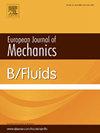克拉克-Y 11.7%水翼在不同攻角、受控溶气水平下的气蚀流基准实验研究
IF 2.5
3区 工程技术
Q2 MECHANICS
引用次数: 0
摘要
本研究旨在研究具有可变攻角 (α) 的 CLARK-Y 11.7 % 水翼周围的空化流,同时保持工作流体(水)中可控的溶解空气水平。利用水隧道设施进行了一系列实验,使用传感器和高速成像技术对空化特性进行了测量和观察。本次研究的变量为空化数(1 ≤ σ ≤ 2.2)和攻角(α = 4°、6°、8°、10°和 12°),溶解空气含量(DAL)范围为 9.3 ppm 至 13.1 ppm。无量纲空腔长度随着 σ/α 值的增加而显著减小,这表明存在一种反比关系,即空化数越高或攻击角越小,空腔越短。空腔长度遵循幂律缩放关系,经验公式为 Lmax/C=4.78×σ/α-0.76 。增加攻角可将空化性质从稳定(模式 I)转变为动态(模式 II)和高度振荡(模式 III)。空腔越大,斯特劳哈尔数越低,这表明涡流脱落活动越少。斯特劳哈尔数与归一化空化数 σ/α 之间的关系用幂律方程 St=0.041×σ/α0.3 表示。本研究提供了广泛的数据集和经验相关性,可作为基准框架,便于验证类似条件下气蚀流的计算和实验模型。本文章由计算机程序翻译,如有差异,请以英文原文为准。
Benchmark experimental study on cavitating flow around Clark-Y 11.7 % hydrofoil at various angles of attack under controlled levels of dissolved air
The present research aims to study cavitating flow around a CLARK-Y 11.7 % hydrofoil with variable angles of attack (α) while maintaining controlled levels of dissolved air in the operating fluid, which is water. A series of experiments were conducted using a water tunnel facility, where the cavitation characteristics were measured and observed using sensors and high-speed imaging techniques. The variables studied in the present work are cavitation number (1 ≤ σ ≤ 2.2) and angle of attack (α = 4°, 6°, 8°, 10°, and 12°), with dissolved air levels (DAL) in the range of 9.3 ppm to 13.1 ppm. The dimensionless cavity length decreases significantly with increasing values of σ/α, indicating an inverse relationship where higher cavitation numbers or lower angles of attack result in shorter cavities. The cavity length follows a power-law scaling relationship, with the empirical equation .Increasing the angle of attack transitions the cavitation nature from stable (Mode I) to dynamic (Mode II) and highly oscillating (Mode III). Larger cavities result in lower Strouhal numbers, which indicates reduced vortex shedding activity. The relationship between the Strouhal number and the normalized cavitation number σ/α is characterized by the power-law equation . The pressure coefficient at the leading-edge increases with the angle of attack at low cavitation numbers, while higher cavitation numbers lead to greater pressure coefficient differences between the leading and trailing edges.
The present study offers an extensive dataset and empirical correlations that may serve as a benchmark framework, which facilitates the validation of computational and experimental models of cavitating flow under similar conditions.
求助全文
通过发布文献求助,成功后即可免费获取论文全文。
去求助
来源期刊
CiteScore
5.90
自引率
3.80%
发文量
127
审稿时长
58 days
期刊介绍:
The European Journal of Mechanics - B/Fluids publishes papers in all fields of fluid mechanics. Although investigations in well-established areas are within the scope of the journal, recent developments and innovative ideas are particularly welcome. Theoretical, computational and experimental papers are equally welcome. Mathematical methods, be they deterministic or stochastic, analytical or numerical, will be accepted provided they serve to clarify some identifiable problems in fluid mechanics, and provided the significance of results is explained. Similarly, experimental papers must add physical insight in to the understanding of fluid mechanics.

 求助内容:
求助内容: 应助结果提醒方式:
应助结果提醒方式:


